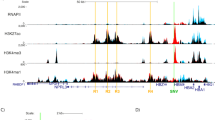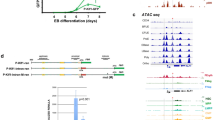Abstract
The five human β-type-globin genes, ε, Gγ, Aγ, δ and β, are close together and are regulated by a locus control region (LCR) located at the 5′ end of the locus1,2. Here we investigate the functional consequences of this organization with respect to temporal regulation of the individual genes, by using recombination techniques to invert the order of either the genes or the LCR in vivo. Our analysis of transgenic mice bearing either normal or mutant transgenes leads to two new observations. First, the position of the ε-globin gene next to the LCR is mandatory for its expression during the yolk-sac stage of erythropoiesis. Second, LCR activity is orientation dependent, and so the LCR does not act as a simple enhancer to stimulate transcription of the globin genes. Thus, in the absence of any change in transgene integration position, transgene copy number, trans-acting factors or other resident genetic information, simple inversion of the human genes or the LCR fundamentally alters the transcription of β-type globin genes.
This is a preview of subscription content, access via your institution
Access options
Subscribe to this journal
Receive 51 print issues and online access
$199.00 per year
only $3.90 per issue
Buy this article
- Purchase on Springer Link
- Instant access to full article PDF
Prices may be subject to local taxes which are calculated during checkout




Similar content being viewed by others
References
Stamatoyannopoulos, G. & Nienhuis A. W. in The Molecular Basis of Blood Diseases 2nd edn (eds Stamatoyannopoulos, G., Nienhuis, A. W., Majerus, P. & Varmus, H.107–155 (Saunders, New York, (1994).
Hardison, R. et al. Locus control regions of mammalian β-globin gene clusters: combining phylogenetic analyses and experimental results to gain functional insights. Gene 205, 73–94 (1997).
Hanscombe, O. et al. Importance of globin gene order for correct developmental expression. Genes Dev. 5, 1387–1394 (1991).
Peterson, K. R. & Stamatoyannopoulos, G. Role of gene order in developmental control of human γ- and β-globin gene expression. Mol. Cell. Biol. 13, 4836–4843 (1993).
Dillon, N., Trimborn, T., Strouboulis, J., Fraser, P. & Grosveld, F. The effect of distance on long-range chromatin interactions. Mol. Cell 1, 131–139 (1997).
Choi, O. -R. & Engel, J. D. Developmental regulation of β-globin gene switching. Cell 55, 17–26 (1988).
Foley, K. P. & Engel, J. D. Individual stage selector element mutations lead to reciprocal changes in β- vs. ε-globin gene transcription: genetic confirmation of promoter competition during globin gene switching. Genes Dev. 6, 730–744 (1992).
Martin, D. I. K., Fiering, S. & Groudine, M. Regulation of β-globin gene expression: straightening out the locus. Curr. Opin. Genet. Dev. 6, 488–495 (1996).
Bungert, J. et al. Synergistic regulation of human β-globin gene switching by locus control region elements HS3 and HS4. Genes Dev. 9, 3083–3096 (1995).
Milot, E. et al. Heterochromatin effects on the frequency and duration of LCR-mediated gene transcription. Cell 87, 105–114 (1996).
Sauer, B. & Henderson, N. Cre-stimulated recombination at loxP-containing DNA sequences placed into the mammalian genome. Nucleic Acids Res. 17, 147–161 (1989).
Ramirez-Solis, R., Liu, P. & Bradley, A. Chromosome engineering in mice. Nature 378, 720–724 (1995).
Gaensler, K. M., Kitamura, M. & Kan, Y. W. Germ-line transmission and developmental regulation of a 150-kb yeast artificial chromosome containing the human β-globin locus in transgenic mice. Proc. Natl Acad. Sci. USA 90, 11381–11385 (1993).
Liu, Q., Bungert, J. & Engel, J. D. Mutation of gene-proximal regulatory elements disrupts human ε-, γ-, and β-globin expression in yeast artificial chromosome transgenic mice. Proc. Natl Acad. Sci. USA 94, 169–174 (1997).
Enver, T. et al. Developmental regulation of human fetal-to-adult globin gene switching in transgenic mice. Nature 344, 309–313 (1990).
Wijgerde, M., Grosveld, F. & Fraser, P. Transcription complex stability and chromatin dynamics invivo. Nature 377, 209–213 (1995).
Reik, A. et al. The locus control region is necessary for gene expression in the human β-globin locus but not the maintenance of an open chromatin structure in erythroid cells. Mol. Cell. Biol. 18, 5992–6000 (1998).
Li, Q. & Stamatoyannopoulos, G. Hypersensitive site 5 of the human β locus control region functions as a chromatin insulator. Blood 84, 1399–1401 (1994).
Zafarana, G., Raguz, S., Pruzina, S., Grosveld, F. & Meijer, D. in Molecular Biology of Hemoglobin Switching(ed. Stamatoyannopoulos, G.) 39–44 (Intercept, Andover, (1995).
Fraser, P., Pruzina, S., Antoniou, M. & Grosveld, F. Each hypersensitive site of the human β-globin locus control region confers a different developmental pattern of expression on the globin genes. Genes Dev. 7, 106–113 (1993).
Yu, J., Bock, J. H., Slightom, J. L. & Villeponteau, B. A5′ β-globin matrix-attachment region and the polyoma enhancer together confer position-independent transcription. Gene 139, 139–145 (1994).
Hogan, B., Costantini, F. & Lacy, E. Manipulating the Mouse Embryo(Cold Spring Harbor Press, Cold Spring Harbor, (1986).
Sauer, B. & Henderson, N. Targeted insertion of exogenous DNA into the eucaryotic genome by the cre recombinase. New Biol. 2, 441–449 (1990).
Liu, Q., Tanimoto, K., Bungert, J. & Engel, J. D. The Aγ-globin 3′ element provides no unique function(s) for human β-globin locus gene regulation. Proc. Natl Acad. Sci. USA 95, 9944–9949 (1998).
Acknowledgements
We thank Y. Tanimoto, J. Fan and R. Arora for help with this work. We also acknowledge the support of the Japan Society for the Promotion of Science and the Naito Foundation (K.T.), the Cooley's Anemia Foundation (K.T. and Q.L.) and the American Heart Association (J.B.) for fellowship support, and the Robert H. Lurie Comprehensive Cancer Center and the NIH for research support (J.B. and J.D.E.)
Author information
Authors and Affiliations
Additional information
Correspondence and requests for materials should be addressed to J.D.E.
Rights and permissions
About this article
Cite this article
Tanimoto, K., Liu, Q., Bungert, J. et al. Effects of altered gene order or orientation of the locus control region on human β-globin gene expression in mice. Nature 398, 344–348 (1999). https://doi.org/10.1038/18698
Received:
Accepted:
Issue Date:
DOI: https://doi.org/10.1038/18698
Comments
By submitting a comment you agree to abide by our Terms and Community Guidelines. If you find something abusive or that does not comply with our terms or guidelines please flag it as inappropriate.



